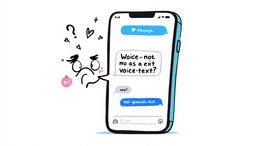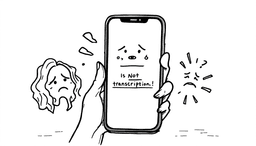
Learn how to send voice memos on iMessage with step-by-step instructions, troubleshooting tips, and how voice messages enhance business communication.
Quick Answer
To send a voice memo on iMessage: Open Messages → Open chat → Tap + icon → Select Audio → Tap microphone to record → Stop recording → Send. You can also hold the microphone button while recording for quick send.
Method 1: Direct Voice Recording in iMessage
Step-by-Step Instructions
- Open the Messages App: Launch the Messages app on your iPhone and open the chat where you want to send the voice memo.
- Tap the + Icon: Look for the + icon next to the text field at the bottom of your screen and tap it.
- Select Audio: Look for the Audio option (icon looks like sound waves) and tap it. Recording starts immediately.
- Record Your Message: Start speaking immediately - the voice message begins recording as soon as you tap the Audio icon.
- Stop and Send: Tap the red microphone button again to stop recording, then tap the blue arrow to send or X to cancel.
Pro Tip: You can tap the play button to review your message before sending it!
Method 2: Hold and Record (Quick Send)
Alternative Recording Method
- Press and Hold Audio Button: Instead of just tapping, press and hold the Audio icon while you record your message.
- Release to Send: Release your finger to automatically send the recording, or slide left to cancel.
Speed Tip: This method is perfect for quick voice messages when you are in a hurry!
Method 3: Sending Pre-recorded Voice Memos
Using the Voice Memos App
- Open Voice Memos App: Launch the Voice Memos app on your iPhone, iPad, or Mac.
- Record Your Message: Hit the record button, record your message, and tap stop when finished.
- Share to Messages: Tap the More button (three dots) → Share → Messages → Select recipient → Send.
Advantage: This method lets you edit, trim, and perfect your recording before sending!
Troubleshooting Common Issues
Voice Messages Not Working
Problem: Sound Recognition is On
This is the most common issue preventing voice recording.
Solution: Go to Settings → Accessibility → Sound Recognition → Turn OFF
Problem: Microphone Permissions
Voice Memos requires microphone access.
Solution: Settings → Privacy & Security → Microphone → Enable for Messages/Voice Memos
Recording Issues
Problem: No Storage Space
Voice memos need storage to save recordings.
Solution: Free up iPhone storage by deleting unused apps or files
Problem: External Audio Devices
Bluetooth speakers can interfere with recording.
Solution: Disconnect external speakers and try again
Quick Fixes
- Force close and restart the Messages app
- Restart your iPhone to clear temporary glitches
- Update iOS to the latest version
- Reset all settings if issues persist (last resort)
- Contact Apple Support for hardware problems
Voice Message Features & Tips
Message Duration
- Voice messages auto-expire after 2 minutes
- Recipients can tap Keep to save permanently
- Saved messages go to Voice Memos app
Playback Controls
- Slide left/right to fast forward/rewind
- Tap and hold play button for speed control
- Long press voice message to save or forward
Requirements
- Both sender and receiver must be signed into iMessage
- Audio recording only works when phone is unlocked
- Works on iPhone, iPad, and Mac with iMessage
Pro Tips
- Swipe left on microphone for hands-free recording
- Use stereo recording in Settings for better quality
- Connect external mic for professional audio
Voice Messages in Business Communication
Professional Benefits of Voice Messaging
Communication Advantages
- Conveys tone and emotion better than text
- Faster than typing long messages
- Builds personal connections in remote teams
- Reduces misunderstandings through voice context
- Perfect for brainstorming and quick updates
Business Use Cases
- Meeting follow-ups and action items
- Project status updates for team members
- Client communications with personal touch
- Training and onboarding instructions
- Feedback and coaching sessions
Legal Considerations
Laws around recording vary by location. Some regions require one-party consent, others need all-party consent. Check your local regulations before recording business conversations.
From Voice Messages to AI Meeting Intelligence
Transform Voice Communications with AI
While iPhone voice messages are great for personal communication, professional teams need more powerful tools to transcribe, analyze, and summarize voice communications from meetings and calls.
Recommended AI Tools
Fireflies.ai: Automatic meeting transcription with speaker identification and searchable recordings. Perfect for team meetings and client calls.
Notta: Multi-language transcription with real-time collaboration features. Great for international teams.
Otter.ai: Live transcription with meeting summaries and action item extraction. Ideal for lectures and interviews.
Level Up Your Voice Communications
Ready to move beyond basic voice messages? Discover AI tools that can automatically transcribe meeting recordings, extract action items and key decisions, generate meeting summaries and notes, search through months of meeting content, and integrate with your existing workflow.
Voice Messaging vs AI Meeting Tools
Comparison: iPhone Voice Messages (Manual 1-on-1 recording, no transcription, not searchable, manual summaries, best for personal communication) vs AI Meeting Tools (Automatic multi-participant recording, AI-powered transcription with speaker ID, full-text search, AI-generated summaries, best for professional meetings and documentation).
Best Practices for Voice Messages
Dos
- Keep messages under 60 seconds for better engagement
- Speak clearly and at normal pace
- Use in quiet environments for better audio quality
- Preview before sending important messages
- Follow up with text for key action items
- Use quality headphones for professional calls
Donts
- Do not send voice messages when text would be clearer
- Avoid recording in noisy environments
- Do not assume all recipients can listen immediately


